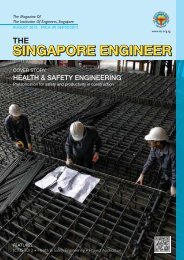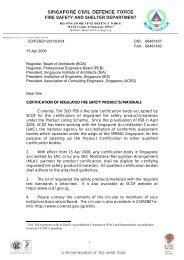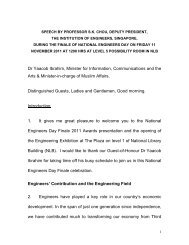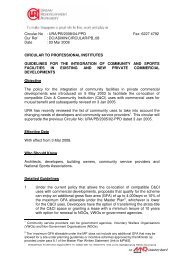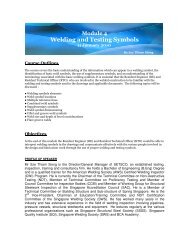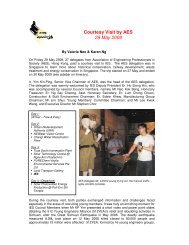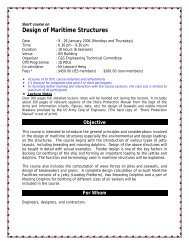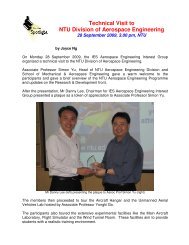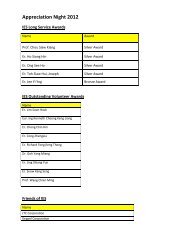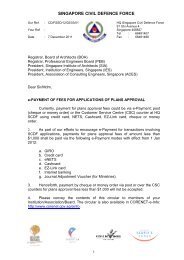THE SINGAPORE ENGINEER - Institution of Engineers Singapore
THE SINGAPORE ENGINEER - Institution of Engineers Singapore
THE SINGAPORE ENGINEER - Institution of Engineers Singapore
Create successful ePaper yourself
Turn your PDF publications into a flip-book with our unique Google optimized e-Paper software.
SYSTEMS COVER <strong>ENGINEER</strong>ING<br />
STORY<br />
Deployment <strong>of</strong> Requirements Management<br />
in Rolls-Royce<br />
Mr Lee Glazier, Chief <strong>of</strong> World Class Systems, Rolls-Royce plc, UK , was tasked, in October<br />
2007, with deploying Best Practice Requirements Management across the whole company.<br />
In this article, he describes the issues associated with the existent state <strong>of</strong> Requirements<br />
Management practice, information model options and selection, and formal codification in<br />
a quality process. The article also discusses the importance <strong>of</strong> recognising uncertainty, and<br />
change leadership methods used in deployment including process and tool training, support<br />
aids and the methodology selected to continue the deployment across Rolls-Royce.<br />
BACKGROUND<br />
Rolls-Royce is a global business providing power systems for<br />
use on land, at sea, and in the air. The company has a balanced<br />
business portfolio with positions in the civil and defence<br />
aerospace, marine and energy markets. It operates in five<br />
segments - Civil Aerospace, which is engaged in the development,<br />
manufacture, marketing and sales <strong>of</strong> commercial aero engines<br />
and aftermarket services; Defence Aerospace, which is engaged<br />
in the development, manufacture, marketing and sales <strong>of</strong> military<br />
aero engines and aftermarket services; Marine, which is engaged<br />
in the development, manufacture, marketing and sales <strong>of</strong> marine<br />
propulsion systems and aftermarket services; Energy, which is<br />
engaged in the development, manufacture, marketing and sales<br />
<strong>of</strong> power systems for the <strong>of</strong>fshore oil and gas industry, electrical<br />
power generation and aftermarket services; and Nuclear,<br />
which will play a key role in the UK’s nuclear reactor new build<br />
programme, with the largest nuclear skills base in the UK, and an<br />
existing nuclear certified supply chain <strong>of</strong> 260 companies.<br />
This complex organisation presented particular challenges both<br />
in terms <strong>of</strong> scope (38,000 employees) and diversity <strong>of</strong> product/<br />
service. A further complication was presented by the intention<br />
that Requirements Management was to also embrace the ‘nontechnical’<br />
domains.<br />
EXISTENT STATE<br />
Before 2007, Rolls-Royce Requirements Management was<br />
formalised and mature in two main areas. Within Defence<br />
Aerospace, Requirements Management was very formalised<br />
for joint projects, for example, the F136 Engine for the F-35<br />
Joint Strike Fighter with General Electric. Also, the Controls<br />
departments had good, formalised and mature Requirements<br />
Management. Additionally, there were good, localised examples<br />
across the whole enterprise. There was no explicit requirements<br />
elicitation or management process beyond the definition <strong>of</strong> a<br />
range <strong>of</strong> requirement and definition documents in one top level<br />
engineering process.<br />
PROBLEM WITH EXISTENT STATE AND<br />
RESULTANT ORGANISATIONAL DECISION<br />
The most obvious issues with the above state are around<br />
22 <strong>THE</strong> <strong>SINGAPORE</strong> <strong>ENGINEER</strong> April 2012<br />
consistency and governance. There are significant effects<br />
stemming from these issues - tools, training, resourcing, process,<br />
documentation etc that all add costs to a business.<br />
In 2007, Rolls-Royce appointed a Chief <strong>of</strong> Requirements<br />
Management with the role and objective <strong>of</strong> deploying Best<br />
Practice Requirements Management across the complete<br />
enterprise.<br />
INFORMATION MODELS<br />
Clearly, to be successful in a company-wide deployment, with<br />
a majority <strong>of</strong> employees who were inexperienced in formal<br />
Requirements Management tools and process, the chosen<br />
information model, principles, process and tools needed to be<br />
simple but effective.<br />
Is suspicion sufficient?<br />
The classic information model shows requirements linked to<br />
derived requirements or definitions. This provides traceability<br />
effectively between the solution and the requirement. If a formal<br />
Requirements Management tool is used, for example DOORS,<br />
then any change within the landscape will generate suspicious<br />
links. This is not helpful. Senior Management is not particularly<br />
interested in hearing that a particular change now makes an<br />
engineer ‘suspicious’ that the original requirement may now not<br />
be met. They want to know whether the requirement will be<br />
met, and if not, how big will be the non-compliance. A further<br />
issue with this classic information model is the complexity <strong>of</strong><br />
linkages created when a number <strong>of</strong> requirements result in a<br />
large number <strong>of</strong> the same set <strong>of</strong> derived requirements - a ‘some<br />
to many’ relationship. In this circumstance, the value <strong>of</strong> suspicious<br />
links becomes questionable. In this case also, the number <strong>of</strong> links<br />
that needs maintaining can become prohibitively large.<br />
All requirements need to be complied with - do they<br />
all need to be managed?<br />
All requirements need to be complied with. Does this mean they<br />
all need to be managed? The answer must be ‘yes’. However, at<br />
first glance, the opposite may appear true and that depends on<br />
levels <strong>of</strong> abstraction. At the system level, one is unlikely to be<br />
devoting much attention to the requirements <strong>of</strong> screw threads



